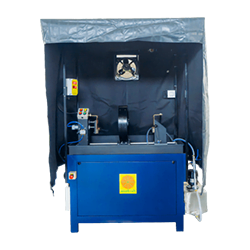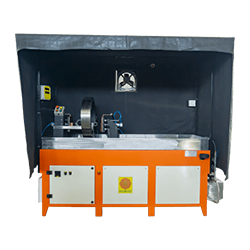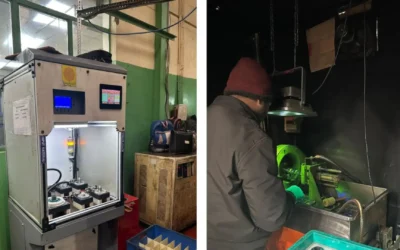
These parts need to be magnetized in two directions perpendicular to each other. A Circular magnetic field is generated by passing a current through the length of the part.
Calculation of head shot current is done as per the formula given in ASTM standards.
Head Shot Current = 20 X Diameter (in mm)
In the above formula, the diameter should be taken as the maximum distance between any two points along the length of the part.
Circular magnetic field is used to detect longitudinal flaws in the part.
Longitudinal magnetic field, required to detect transverse defects is generated by using one or more encircling coils.
As per ASTM standards, the length of the part shaft magnetized by the coil is equal to the inside diameter of the coil.
To cover the entire length of the partthe coil must be moved to different points along the length of the part separated by 90% of the coil diameter. This will ensure the 10% overlap specified in the ASTM standards.
Formula for calculation of coil current

In the above formula, the diameter should be taken as the average diameter of the part.
![]()
Also, in the above formula for current requirement for coil shot, while calculating L/D ratio, L must be equal to the inside diameter of the coil & not equal to the overall length of the part.
A heavy dutybench type machine is used to perform magnetic particle testing on railroad parts. The part is placed on the machine by using specially designed fixtures. A pneumatically operated arrangement is used to clamp the part from both ends. Pneumatic clamping ensures that there is no sparking when high current is passed through the part. Use of braided copper pads is also recommended to eliminate arcing sparks.
Conventional Technique
A two vector PLC based bench type magnetic crack detector machine is used to perform testing on the railroad parts.

Testing Procedure for conventional machines
- Clean up & dry the part’s surface before inspecting.
- The partis placed on the fixture.
- Now apply magnetic solution bath to the part.
- Press the ‘Cycle Start’ button.
- The part automatically gets clamped.
- Stop the flow of bath.
- Now, the current passes through the part.
- It shows up on the digital metering unit.
- The part automatically gets de-clamped.
- Inspect the part under UV light for longitudinal defects. Rotate on steady rollers.
- Position the coil to its 1st position.
- Now, again apply bath to the job.
- Press the ‘Cycle Start’ button.
- Stop the flow of bath.
- Now the current passes through the coil.
- It shows up on the digital metering unit.
- Inspect the part under UV light for transverse defects. Rotate on Rollers
- Move the coil to next position & repeat the above 6 steps.
- Demagnetize
suitable products
Standard MPI Machines
Engineered for precision and efficiency, the Standard Bench Type Magnetic Particle Testing Machine is suitable for entry level testing.
PLC Controlled MPI Bench
With PLC Controlled bench type Magnetic Particle Inspection Machine, you can accurately control the process parameters for reilable results.
Multidirectional MPI Bench
The ultimate solution for robust non-destructive testing, this machine offers multi-directional magnetization for inspection in all directions in one shot..
Demagnetizers
Demagnetizers stand as a key tool in maintaining excellence in production, with the flexibility to handle different materials and magnetism levels, coupled with energy-efficient and user-friendly design.
DIVE DEEPER: GET YOUR HANDS ON OUR PRODUCT BROCHURE!
Explore More, Discover Better!
- In-Depth Details
- Product Insights
- Expert Recommendations
Download Our Brochure Now!
Blogs
Magnetic Particle Testing Equipment: A Vital Tool for Quality Control in India
In today's fast-paced industrial landscape, ensuring the integrity and reliability of materials is critical. From aerospace and automotive industries to oil and gas, the safety of infrastructure and equipment is non-negotiable. One of the most trusted non-destructive...
The Essential Role of Magkraft’s MPI Products in Non-Destructive Testing
In the realm of Non-Destructive Testing (NDT), Magnetic Particle Inspection (MPI) stands out as a highly effective method for detecting surface and near-surface defects in ferromagnetic materials. MPI products are crucial components in this process, enabling...
Addressing Common Challenges in NDT: Solutions by Magkraft
Non-destructive testing (NDT) is critical in ensuring the integrity and reliability of materials and components across various industries. However, like any technical field, NDT has challenges that can impact inspection outcomes and efficiency. In this article, we'll...









